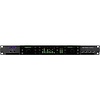Anyone who wants to record live musicians using a Digital Audio Workstation must deal with the latency that is inherent in the digital recording process. The bottom line is that you want the performer to experience the immediacy that you would get with analogue recording.
But in any native system, lowering the latency comes at a price: the lower the latency, the less processing power you have for your mixes. One of the benefits of the flagship Pro Tools HDX system has always been that you have both power and low-latency on-demand because the HDX DSP chips are dedicated to the task of processing audio. Carbon now brings that workflow to every Pro Tools user with the Pro Tools Hybrid Engine. With the Hybrid Engine, the mixer is running natively but at any time you can switch tracks from Native Mode to DSP Mode to enable low latency recording and monitoring without having to leave the Pro Tools application.
- 8 mic/line/instrument inputs on combo jacks with Variable Z (impedance adjustment) available for inputs 5 to 8.
- 2 instrument inputs with Variable Z impedance adjustment
- 8 line inputs and 8 line outputs on DB25 connectors
- 16 ADAT inputs and 16 ADAT outputs on 4 optical connectors
- 4 headphone outputs
- Stereo monitor outputs
- Word Clock input and Word Clock output on BNC connectors
- Dual Ethernet connectors
- Footswitch input
- Integrated Talkback microphone
Computer connection is facilitated via the Ethernet ports, using the AVB protocol and Core Audio driver. This way, other DAWs can access the interface in place of Pro Tools. Note that it is possible to connect Carbon to a Thunderbolt 3 port as well, using an Ethernet-to-Thunderbolt adapter.
Through a combination of fast Ethernet connectivity and 8 on-board HDX DSP units, AVID claims sub-millisecond latency monitoring and real-time processing of AAX DSP plug-ins. AD/DA conversion is capped at 192kHz / 32-bit.







